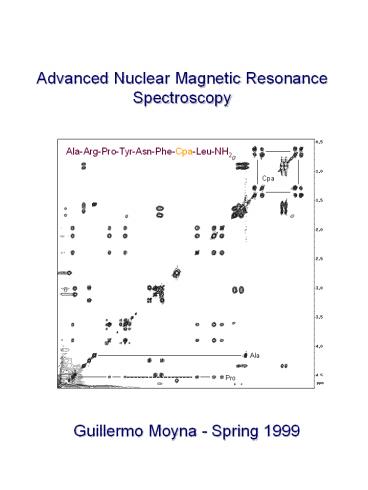Advanced Nuclear Magnetic Resonance - PowerPoint PPT Presentation
Title:
Advanced Nuclear Magnetic Resonance
Description:
Advanced Nuclear Magnetic Resonance Spectroscopy Guillermo Moyna - Spring 1999 Ala-Arg-Pro-Tyr-Asn-Phe-Cpa-Leu-NH2 Cpa Ala Pro – PowerPoint PPT presentation
Number of Views:148
Avg rating:3.0/5.0
Title: Advanced Nuclear Magnetic Resonance
1
Advanced Nuclear Magnetic Resonance Spectroscopy
Guillermo Moyna - Spring 1999
Ala-Arg-Pro-Tyr-Asn-Phe-Cpa-Leu-NH2
Cpa
Ala
Pro
2
- Why bother learning NMR?
- Structural (chemical) elucidation
- Natural product chemistry.
- Synthetic organic chemistry. Analytical tool of
choice of - synthetic chemists.
- Study of dynamic processes
- Reaction kinetics.
- Study of equilibrium (chemical or structural).
- Structural (three-dimensional) studies
3
- The gory details
- Absorption (or emission) spectroscopy, as IR or
UV. Detects - the absorption of radiofrequencies
(electromagnetic radiation) - by certain nuclei in a molecule.
- Unfortunately, some quantum mechanics are needed
to - understand it (a lot to really understand it).
- Only nuclei with spin number (I) ? 0 can
absorb/emit electro- - magnetic radiation.
- Even atomic mass number ? I 0 (12C, 16O)
- Even atomic mass odd number ? I whole
integer - (14N, 2H, 10B)
- Odd atomic mass ? I half integer (1H, 13C,
15N, 31P) - The spin states of the nucleus (m) are
quantified
4
- Background (continued)
- For 1H, 13C, 15N, 31P (biologically relevant
nuclei) then - m 1/2, -1/2
- This means that only two states (energy levels)
can be - taken by these nuclei.
- Another important parameter of each particular
nuclei is - the magnetic moment (m), which can be expressed
as - m g I h / 2p
- It is a vector quantity that gives the direction
and magnitude - (or strength) of the nuclear magnet
5
- Effect of a magnetic field (for I 1/2)
- In the ground state all nuclear spins are
disordered, and there - is no energy difference between them. They are
degenerate - Since they have a magnetic moment, when we apply
a strong - external magnetic field (Bo), they orient
either against or with it
g h / 4p
Bo
6
- Energy and populations
- Upon application of the external magnetic field
we create an - energy difference between nuclei aligned and
against Bo - Each level has a different population (N), and
the difference - between the two is related to the energy
difference by the - Boltzmman distribution
b
Bo gt 0
DE h n
a
Bo 0
7
- Energy and sensitivity
- The energy (for a single spin) is proportional
to the magnetic - moment of the nuclei and the external magnetic
field - E - m . Bo ? E(up) g h Bo / 4p ---
E(down) - g h Bo / 4p - DE g h Bo / 2p
- This has implications on the energy (i.e., the
intensity of the - signal and sensitivity) that each nuclei can
absorb - Bigger magnets (bigger Bo) make more sensitive
NMR - instruments.
- Nuclei with larger g absorb/emit more energy and
are - therefore more sensitive. Sensitivity is
proportional to
g13C 6,728 rad / G g1H 26,753 rad / G
1H is 64 times more sensitive than 13C just
because of the g
8
- Energy and frequency
- Since energy is related to frequency, we can do
some - insightful math
- DE h n
- n g Bo / 2p
- DE g h Bo / 2p
- For 1H in normal magnets (2.35 - 18.6 T), this
frequency is - in the 100-800 MHz range. For 13C, 1/4 of that
g-rays x-rays UV VIS IR m-wave
radio
10-10 10-8 10-6 10-4 10-2
100 102
wavelength (cm)
9
- Precession and spinning tops
- What precession is wo associated with? One thing
that we - left out from the mix is the angular momentum,
l, which - is associated with all nuclei
- Crudely, we can think of the nuclei as being
spinning around - its z axis. If we now consider those nuclei
that have also a - non zero m, we have little spinning atomic
magnets. - Now, if we bring about a big Bo, there will be
an interaction - between m and Bo that generates a torque. No
matter which - is the original direction of m, it will tend to
align with Bo
l
Bo
Bo
m
or...
m
10
- Precession (continued)
- Now it starts getting exciting (?). Since the
nuclei associated - with m is spinning due to l, there are two
forces acting on it. - One that wants to bring it towards Bo, and one
that wants to - keep it spinning. m ends up precessing around
Bo - The best way to picture it is to imagine a
spinning wooden top - under the action of gravity.
wo
m
Bo
11
- Bulk magnetization
- We see the effects on macroscopic magnetization,
Mo, which - is directly proportional to the population
difference (Na - Nb), - in which contributions from different ms have
been averaged - We can decompose each little m in a z
contribution and an - ltxygt plane contribution. The components in the
ltxygt plane
z
z
Mo
x
x
y
y
Bo
Bo
12
- Next class topics
- Bulk magnetization and vector models.
- Simple excitation of average magnetization.
- Laboratory and rotating frames.
- Chemical shift (d)
- Spin-spin coupling (J). Energy diagrams for
systems - of two coupled spins.































